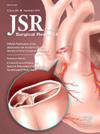胸腔镜修复克鲁特Ⅲb3型食管闭锁和气管食管远端瘘术
IF 1.8
3区 医学
Q2 SURGERY
引用次数: 0
摘要
方法从2012年1月至2024年1月,对10例Kluth Ⅲb3型食管闭锁(EA)和远端气管食管瘘(TEF)患者进行了胸腔镜手术治疗。结果所有手术均在胸腔镜下完成,无转换手术。对其中四例患者进行了术前支气管镜评估,结果显示来自远段的瘘管位于气管T2椎体水平的高位。手术时患者的平均年龄为(2.0±0.7)岁(1-3岁不等),平均体重为(2.6±0.4)公斤(1.8-3.0公斤不等)。整个系列的平均手术时间(皮肤到皮肤)为 137.0 ± 8.9 分钟(120-150 分钟不等)。术后第 8.0 ± 1.9 天(6-12 天)开始口服喂养,术后患者的平均喂养时间为 14.0 ± 2.4 天(12-20 天)。术后情况良好,至今未出现死亡或发病情况。结论小儿外科医生应了解 EA-TEF 的罕见变体,以避免诊断和处理上的误区。KluthⅢb3型EA-TEF患者可以通过胸腔镜手术进行修复。本文章由计算机程序翻译,如有差异,请以英文原文为准。
Thoracoscopic Repair for Kluth Type Ⅲb3 Esophageal Atresia and Distal TracheoesophagealFistula
Introduction
This report aims to present our initial miniseries of successful thoracoscopic repair for esophageal atresia (EA) and distal tracheoesophageal fistula (TEF) of Kluth type Ⅲb3 in accordance with Kluth's classification.
Methods
From January 2012 to January 2024, ten patients with Kluth type Ⅲb3 EA-TEF were treated by thoracoscopic surgery. The therapeutic methods and surgical outcomes were retrospectively reviewed.
Results
All procedures were completed thoracoscopically without conversions. A preoperative bronchoscopy assessment was conducted in four of the cases, revealing that the fistula from the distal segment was located high on the trachea at the level of T2 vertebral. The mean age of the patients at the time of operation was 2.0 ± 0.7 d (range, 1-3 d), and the mean weight at operation was 2.6 ± 0.4 kg (range, 1.8-3.0 kg). The mean operative time (skin to skin) for the entire series was 137.0 ± 8.9 min (range, 120-150 min). Oral feeding was initiated on the postoperative day 8.0 ± 1.9 (range, 6-12 d), and the mean duration for patients after surgery was 14.0 ± 2.4 d (range, 12-20 d). The postoperative period has been uneventful with no occurrences of mortality or morbidity to date. Three cases of formatted anastomotic stricture required at least one esophageal dilation after surgery.
Conclusions
Pediatric surgeons should be aware of the rare variants of EA-TEF to avoid the diagnostic and management pitfalls. Patients with Kluth type Ⅲb3 EA-TEF were amenable to repair by thoracoscopic surgery.
求助全文
通过发布文献求助,成功后即可免费获取论文全文。
去求助
来源期刊
CiteScore
3.90
自引率
4.50%
发文量
627
审稿时长
138 days
期刊介绍:
The Journal of Surgical Research: Clinical and Laboratory Investigation publishes original articles concerned with clinical and laboratory investigations relevant to surgical practice and teaching. The journal emphasizes reports of clinical investigations or fundamental research bearing directly on surgical management that will be of general interest to a broad range of surgeons and surgical researchers. The articles presented need not have been the products of surgeons or of surgical laboratories.
The Journal of Surgical Research also features review articles and special articles relating to educational, research, or social issues of interest to the academic surgical community.

 求助内容:
求助内容: 应助结果提醒方式:
应助结果提醒方式:


